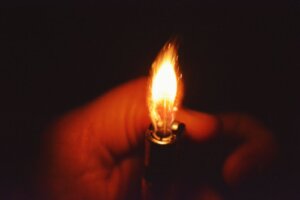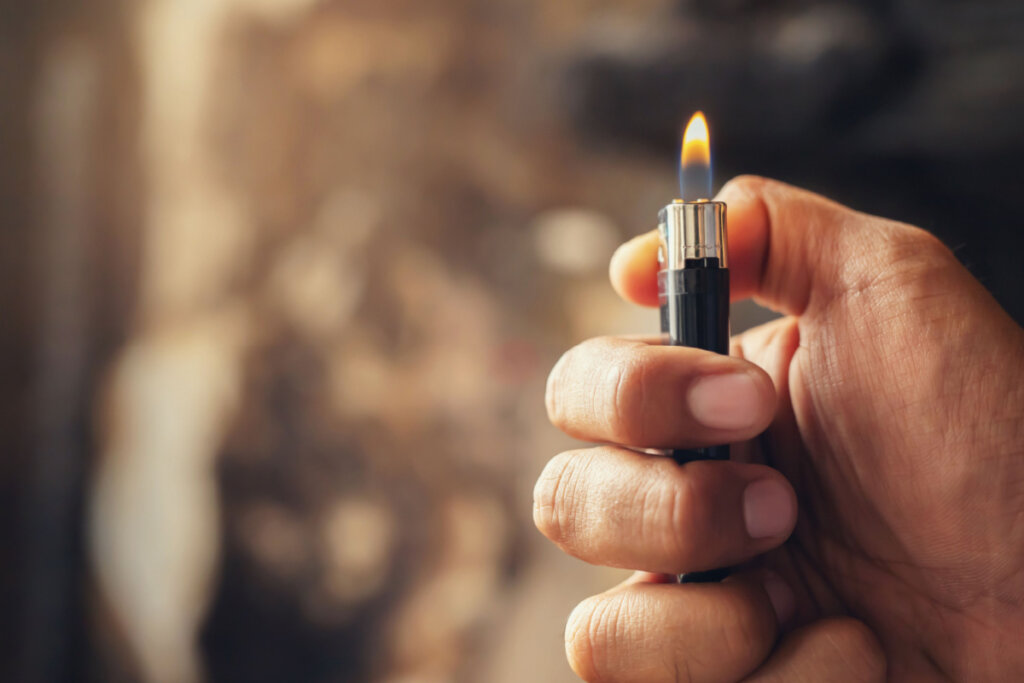Inhaling Lighter Gas: A Dangerous Trend Among the Young


Reviewed and approved by the psychologist Sergio De Dios González
Inhaling lighter gas is a practice that’s gaining popularity among young people. By inhaling this fuel, a series of changes are produced in the body. These include the alteration of consciousness. It can be a satisfying experience for some teens.
However, inhaling lighter gas is a really dangerous trend that’s already claimed the lives of several teenagers. That said, in many countries, there are no defined prevention measures, as there are regarding the consumption of other substances that can be both extremely attractive and dangerous for this sector of the population.
“For millions of people, drugs serve today like religions and high culture did yesterday, to appease doubts and perplexities about the human condition, life, death, the afterlife, the meaning or nonsense of existence.”
-Mario Vargas Llosa-

The effects of inhaling lighter gas
Inhaling lighter gas is a risky activity. This substance is known as isobutane gas. It’s a toxic hydrocarbon for humans. It’s used as fuel and now, it seems, the youngest in our society are attracted by its effects on the nervous system.
From a psychological point of view, the effects of this substance are evasion of reality and euphoria. It provokes a kind of numbness that leads to feelings of being ‘absent’. In fact, inhaling lighter gas causes sensations similar to those obtained with the consumption of alcohol, including disinhibition.
However, it also results in a series of effects, such as:
- Irritation of the mucous membranes.
- Excessive salivation.
- Drowsiness.
- Dizziness.
- Headache.
- Vomiting.
- Lack of coordination.
- Seizures.
- Loss of consciousness.
Moreover, overexposure to this substance can lead to paralysis of the larynx and obstruct the supply of oxygen to the body. This causes a condition known as hypoxia. It also has the potential to cause heart failure. Thus, inhaling lighter gas can be deadly, as it increases the likelihood of sudden death syndrome.
Free access and lack of information
Research indicates that this dangerous practice occurs more commonly among the youngest in our society. More, specifically, in those between the ages of 12 and 17. The practice also seems to be associated with a lack of economic resources or a high degree of control over adolescent behavior by parents. Young people consume these types of products because they’re cheaper than other drugs and also easier to access.
Inhaling lighter gas is the most common practice in this type of consumption. However, similar effects are obtained by inhaling other products. For example, deodorants, computer cleaners, spray paints, and some common solvents like nail polish, nail polish remover, glue, or gasoline, among others.
Both lighters and other potential sources of isobutane gas are extremely accessible to adolescents. They’re cheaper than marijuana, cocaine, or synthetic drugs and offer the effect that young people are looking for: alienation. Unfortunately, regular users of these products are most likely unaware of the serious damage they might be causing themselves.
Prolonged use of these substances causes irreversible damage. For instance:
- Deterioration of myelin. This substance covers the neurons. Its deterioration can cause movement disorders or hallucinations.
- Hearing loss.
- Neuropathies.
- Damage to the central nervous system.

What can be done?
As a rule, the deliberate search for a state of alienation is due to difficulties in dealing with personal reality. Furthermore, adolescence is a critical stage of development in which insecurities, confusion, unfulfilled desires, and feelings of loss and emptiness abound.
Substance use is an option for eliminating these young peoples’ discomfort quickly and temporarily. Feeling ‘good’ for a moment, even at the price of inflicting serious harm on themselves, is attractive to these teens. After all, they’re suffering, and inhaling lighter gas helps them alleviate their pain.
As always, love and education are the keys to facing these phenomena. Therefore, joint action is required between authorities, families, and the community to inform teens about the dangers of these substances. They should also be offered alternatives to help them manage their internal conflicts.
Outright prohibition doesn’t work. As a matter of fact, it usually produces the opposite effect to the one it pursues. Indeed, banning promotes the idea that undertaking the prohibited activity is a challenge. This can be really encouraging for all those who feel like outsiders. On the contrary, enabling healthy alternatives so that teens are able to experiment is an alternative that usually brings better results.
Inhaling lighter gas is a practice that’s gaining popularity among young people. By inhaling this fuel, a series of changes are produced in the body. These include the alteration of consciousness. It can be a satisfying experience for some teens.
However, inhaling lighter gas is a really dangerous trend that’s already claimed the lives of several teenagers. That said, in many countries, there are no defined prevention measures, as there are regarding the consumption of other substances that can be both extremely attractive and dangerous for this sector of the population.
“For millions of people, drugs serve today like religions and high culture did yesterday, to appease doubts and perplexities about the human condition, life, death, the afterlife, the meaning or nonsense of existence.”
-Mario Vargas Llosa-

The effects of inhaling lighter gas
Inhaling lighter gas is a risky activity. This substance is known as isobutane gas. It’s a toxic hydrocarbon for humans. It’s used as fuel and now, it seems, the youngest in our society are attracted by its effects on the nervous system.
From a psychological point of view, the effects of this substance are evasion of reality and euphoria. It provokes a kind of numbness that leads to feelings of being ‘absent’. In fact, inhaling lighter gas causes sensations similar to those obtained with the consumption of alcohol, including disinhibition.
However, it also results in a series of effects, such as:
- Irritation of the mucous membranes.
- Excessive salivation.
- Drowsiness.
- Dizziness.
- Headache.
- Vomiting.
- Lack of coordination.
- Seizures.
- Loss of consciousness.
Moreover, overexposure to this substance can lead to paralysis of the larynx and obstruct the supply of oxygen to the body. This causes a condition known as hypoxia. It also has the potential to cause heart failure. Thus, inhaling lighter gas can be deadly, as it increases the likelihood of sudden death syndrome.
Free access and lack of information
Research indicates that this dangerous practice occurs more commonly among the youngest in our society. More, specifically, in those between the ages of 12 and 17. The practice also seems to be associated with a lack of economic resources or a high degree of control over adolescent behavior by parents. Young people consume these types of products because they’re cheaper than other drugs and also easier to access.
Inhaling lighter gas is the most common practice in this type of consumption. However, similar effects are obtained by inhaling other products. For example, deodorants, computer cleaners, spray paints, and some common solvents like nail polish, nail polish remover, glue, or gasoline, among others.
Both lighters and other potential sources of isobutane gas are extremely accessible to adolescents. They’re cheaper than marijuana, cocaine, or synthetic drugs and offer the effect that young people are looking for: alienation. Unfortunately, regular users of these products are most likely unaware of the serious damage they might be causing themselves.
Prolonged use of these substances causes irreversible damage. For instance:
- Deterioration of myelin. This substance covers the neurons. Its deterioration can cause movement disorders or hallucinations.
- Hearing loss.
- Neuropathies.
- Damage to the central nervous system.

What can be done?
As a rule, the deliberate search for a state of alienation is due to difficulties in dealing with personal reality. Furthermore, adolescence is a critical stage of development in which insecurities, confusion, unfulfilled desires, and feelings of loss and emptiness abound.
Substance use is an option for eliminating these young peoples’ discomfort quickly and temporarily. Feeling ‘good’ for a moment, even at the price of inflicting serious harm on themselves, is attractive to these teens. After all, they’re suffering, and inhaling lighter gas helps them alleviate their pain.
As always, love and education are the keys to facing these phenomena. Therefore, joint action is required between authorities, families, and the community to inform teens about the dangers of these substances. They should also be offered alternatives to help them manage their internal conflicts.
Outright prohibition doesn’t work. As a matter of fact, it usually produces the opposite effect to the one it pursues. Indeed, banning promotes the idea that undertaking the prohibited activity is a challenge. This can be really encouraging for all those who feel like outsiders. On the contrary, enabling healthy alternatives so that teens are able to experiment is an alternative that usually brings better results.
All cited sources were thoroughly reviewed by our team to ensure their quality, reliability, currency, and validity. The bibliography of this article was considered reliable and of academic or scientific accuracy.
- Folgar, M. I., & Horcajadas, F. A. (2022). Una aproximación al panorama actual de las nuevas formas de consumo de drogas. Adicciones, 34(1).
- Rey Doldán, A., Rico Lago, V., & Trigo Vilarelle, C. (2010). Alucinógenos, sustancias volátiles, benzodiacepinas, barbitúricos y otros hipnóticos.
This text is provided for informational purposes only and does not replace consultation with a professional. If in doubt, consult your specialist.







